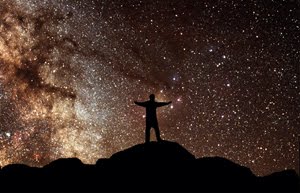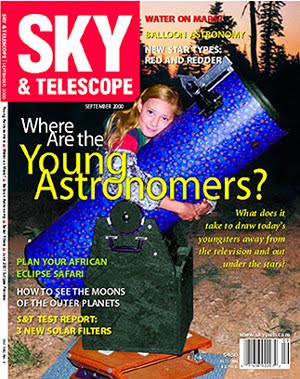After all the comments about the hair-n-muck covered mirror my 8" f/6.9 little dob received at the Messier Marathon last month (nobody even would touch it), I decided to clean both primary and secondary today. I let my 12 year old son get some experience, so I watched and advised, and he did a decent job. Then I did it again to get it really clean (boy, did I get tired scrubbing that thing! ;-)
We went out back and played with the collimation for a bit, and then I pointed it at the moon (yes, me, looking at the moon), and was astonished at the clarity the little scope provided. I was using my 35mm Orion Ultrascopic, and it was dazzling. But, I kept thinking the seeing was coming and going, so I did not get too excited. I peeked around and found Sirius, and decided to star test. What a surprise. Nice rings inside and out of focus. I love slow scopes!
Darkness fell, and it was a shirtsleeve night. I only wish we'd get a night like this at Fisher! I looked at Mars and with a 3.8mm Ultrascopic was able to detect some surface features. A bright spot on the limb, probably the polar cap. Some hints of dark markings, and another white spot near but just off center. Being a deep-sky-guy... I really can't tell you what I was seeing. I'll leave that to the Hacksaw (if you don't know who that is, feel free to ask). Soon it was nice and dark, even with a good 1st Q moon out. So, back to the moon I went. Believe it or not, and this has only happened once before, I was so interested in one crater near the terminator, I decided to draw. Yikes! I could feel full-blown lunacy sweeping over me as I stood with my kitchen light on behind me, peering through the eyepiece, then down at the piece of paper. It was really quite enjoyable once I loosened up and began having fun with it (instead of seeking perfection). I am no lunar artist, but I have posted the sketch to a URL:
http://www.rahul.net/resource/mypics/moon1.gif
Have a look. Maybe someone can tell me what I was seeing (it is a very distinctive crater).
After I finished drawing, I moved to the back of the yard and, using a Meade 10.5mm, popped right onto M81. Boy was I surprised. I had to get my 19mm Panoptic for a wider field to confirm what I was seeing by finding M82 in the same field. This little scope gets good images in town! Then, the test. After some hunting and grunting, I actually detected the cores of M51 and that other smudgey blob. I was impressed I could even see it. M109? No way. M108 or the Owl... ha, not here. The Eskimo? Dropped right on it.... and it did the same trick as the blinking planetary in Cygnus (stare at it, the nebulousity disappears and its just a star, look away slightly and it becomes a nebula again). Down to M35... need aperture... but still nice. Then into Leo... M65 and M66 are there, and not too bad, but the 14.5" in dark sky it's not!
A phone call interrupted me, and when I went back outside the mood was broken. I covered the scope, and went in. About an hour outside, and it was great. Sometimes I think the quick "mental breaks" in my backyard are the most rewarding (but maybe I'm just rationalizing between new moons).











